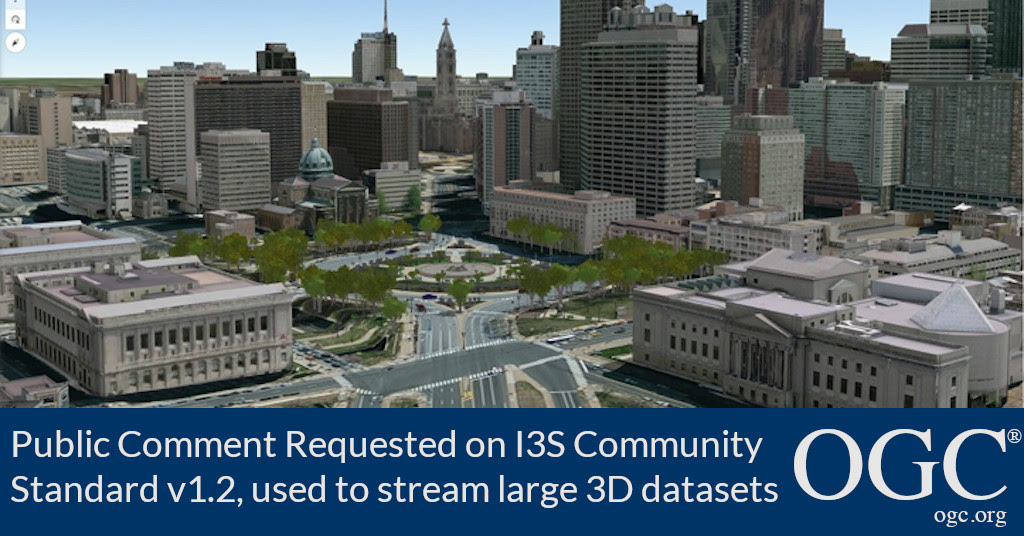New version of the I3S Community Standard, used for streaming large 3D datasets to desktop and mobile devices, improves performance and scalability with enhancements to 3D Object and Integrated Mesh layers
Contact: [email protected]
16 June 2021: The Open Geospatial Consortium (OGC) seeks public comment on version 1.2 of the OGC Indexed 3d Scene Layer (I3S) and Scene Layer Package (*.slpk) Format Community Standard. Comments are due by July 16, 2020.
I3S enables the streaming and storage of arbitrarily large amounts of 3D geographic data. An I3S dataset, referred to as a Scene Layer, can consist of millions of discrete 3D objects with attributes, integrated surface meshes, symbolized points, or point cloud data covering vast geographic areas. Designed for performance and scalability, a scene layer enables the efficient encoding and transmission of geospatial content for an interactive visualization experience on web browsers, mobile, and desktop apps for both offline and online access.
I3S is web and cloud friendly and is rooted in modern standards and technological advancements in the areas of 3D graphics, data structuring, and mesh and texture compression. I3S is accessible for efficient client-side filtering. I3S empowers city and local governments, content providers, and GIS professionals to share scene layers consisting of terabytes of nation-wide point cloud coverage, city and site scale 3D mesh data collected at frequent intervals, 3D planning scenarios fusing both ‘as built’ and modeled information, and more. The increased accessibility and ease of consumption of geospatial content by both domain experts as well as casual users is being rapidly accelerated by standards such as I3S.
The changes included in v1.2 of the OGC I3S Community Standard include:
- Enhanced performance and scalability.
- Introduction of paged node access pattern which significantly reduces the client-server traffic by bundling individual node metadata resources into compact pages of nodes.
- Support for Draco geometry compression. Draco compression of I3S geometry attributes creates more compact nodes, which in turn provides a smaller payload, increasing performance.
- Support for Basis Universal Texture format in Khronos KTX2 standard.
- More optimal selection strategy – standardizes on Oriented Bounding Boxes (OBBs) based node selection criterion.
- Support for advanced material definitions such as physically based materials. Feature compatible with Khronos glTF standard.
- Numerous editorial updates/corrections.
This version 1.2 of the OGC Community Standard mirrors version 1.7 of the original Esri Scene Layers: Service and Package Standard. For more information visit the Esri I3S Spec GitHub page.
The OGC Indexed 3d Scene Layer (I3S) and Scene Layer Package (*.slpk) Format Candidate Community Standard Version 1.2 is available for review and comment on the OGC Portal. Comments are due by July 16, 2020, and should be submitted via the method outlined on the OGC Indexed 3d Scene Layer (I3S) and Scene Layer Package (*.slpk) Format Candidate Community Standard Version 1.2’s public comment request page.
About OGC
The Open Geospatial Consortium (OGC) is an international consortium of more than 500 businesses, government agencies, research organizations, and universities driven to make geospatial (location) information and services FAIR – Findable, Accessible, Interoperable, and Reusable.
OGC’s member-driven consensus process creates royalty free, publicly available geospatial standards. Existing at the cutting edge, OGC actively analyzes and anticipates emerging tech trends, and runs an agile, collaborative Research and Development (R&D) lab that builds and tests innovative prototype solutions to members’ use cases.
OGC members together form a global forum of experts and communities that use location to connect people with technology and improve decision-making at all levels. OGC is committed to creating a sustainable future for us, our children, and future generations.
Visit ogc.org for more info on our work


